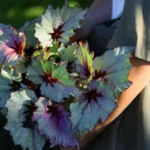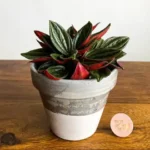Meet Calathea Ornata: A Striking Beauty for Indoor Plant Lovers
For plant enthusiasts who love vibrant foliage and living decor, the Calathea ornata is a showstopper. Known commonly as the “Pinstripe Plant,” this tropical houseplant is beloved for its elegant dark green leaves adorned with delicate pink or white stripes. Native to South America, particularly Colombia, Calathea ornata brings a stunning visual appeal to indoor spaces while also offering an engaging care routine.
Because it can be a little finicky, Calathea ornata often intimidates beginner gardeners. But with some understanding of its tropical origins and a bit of dedication, anyone can successfully cultivate this plant indoors. Let’s explore everything you need to know to help your Calathea ornata thrive.
Understanding Its Natural Habitat
Calathea ornata naturally grows in the understory of tropical rainforests where it enjoys warmth, humidity, and filtered light. In its native environment, it’s protected from direct sunlight by the forest canopy and thrives in moist, well-draining soil. Recreating these conditions indoors is key to keeping your Calathea healthy and vibrant.
Light Requirements
Lighting is a critical factor in the success of Calathea ornata. Too much sun, and its beautiful stripes will fade; too little, and the plant may stop growing.
- Ideal Light: Bright, indirect light. East-facing windows are often best.
- Too Much Sun: Direct sunlight can scorch the leaves, leading to faded colors and brown edges.
- Too Little Light: While it tolerates lower light levels better than some other houseplants, growth may slow down significantly in dim settings.
If natural light is insufficient, a grow light that mimics daylight spectrum can be very helpful.
Watering and Humidity
Watering is often the trickiest part of Calathea ornata care. These plants are sensitive to both overwatering and underwatering, as well as to the quality of water used.
Watering Tips:
- Use distilled or rainwater: Calatheas dislike chlorine, fluoride, and other minerals found in tap water.
- Keep soil consistently moist: Water when the top inch of soil feels dry. Never let the soil completely dry out or become waterlogged.
- Drainage is crucial: Ensure your pot has drainage holes to prevent root rot.
Humidity Needs:
Calathea ornata thrives in high humidity, ideally 50% or higher. Dry air can cause curled leaves and crispy tips. Try these strategies to increase humidity:
- Use a room humidifier nearby, especially during winter.
- Place your plant on a pebble tray filled with water (but not touching the pot’s base).
- Group plants together to create a more humid microclimate.
Temperature and Placement
As a tropical plant, Calathea ornata prefers warm conditions with stable temperatures. Ideal temperatures range between 65°F to 80°F (18°C to 27°C). Avoid exposing it to cold drafts or sudden temperature shifts.
Do not place your plant near:
- Air conditioners or heating vents
- Open windows during colder months
- Direct sunbeams from south-facing windows
Soil and Repotting
A well-draining, moisture-retentive soil mix is ideal. A good indoor mix can be made by combining equal parts of:
- Peat or coco coir (for moisture retention)
- Perlite (for drainage)
- Pine bark (for structure and airflow)
You should repot your Calathea every 1–2 years, preferably in the spring, when it may become root-bound or the soil degrades over time. Choose a pot only one size larger than the previous one to avoid excess moisture retention from too much soil.
Feeding and Fertilization
To support leaf production and vibrancy, feed Calathea ornata with a balanced, diluted houseplant fertilizer (such as 10-10-10) once a month during the active growing season (spring and summer). Avoid overfertilization, which can lead to salt buildup and brown leaf tips.
- Only feed when the soil is moist—never on dry soil.
- Reduce or stop feeding in fall and winter when growth slows down.
Common Issues and How to Fix Them
Browning Tips
This is often due to low humidity or hard water. Switch to distilled water and increase ambient humidity.
Curled Leaves
Curled leaves usually indicate underwatering or too much direct sunlight. Adjust your watering schedule and relocate the plant if needed.
Pale Stripes
If the pink or white stripes begin to fade, the plant might be getting too much light. Move it to a shadier spot with bright, indirect light.
Pest Problems
While not highly susceptible to pests, Calathea ornata can occasionally attract:
- Spider mites: Look for tiny webs under leaves.
- Mealybugs: These appear as cottony clusters, especially near leaf joints.
- Fungus gnats: Usually due to overly moist soil and poor drainage.
Treat with neem oil sprays, insecticidal soap, or wipe leaves with diluted alcohol for mealybugs. Improve air circulation and soil care to prevent recurring infestations.
Propagation
Calathea ornata is best propagated through division, not cuttings. The best time to divide the plant is during repotting in spring.
Steps to propagate by division:
- Gently remove the plant from its pot and shake off excess soil.
- Separate clumps of stems with healthy roots from the main plant, using a sterile knife if necessary.
- Place divisions in separate pots with fresh soil and water them well.
- Keep the new plants in a high humidity environment until they establish.
Calathea Ornata’s Unique Behavior: Prayer Plant Motion
Like other members of the Marantaceae family, Calathea ornata exhibits nyctinasty—a daily rhythmic movement where the leaves rise at night and lower during the day, similar to praying hands. This charming trait, often called the “prayer plant” movement, makes Calathea ornata a delightful addition to any living space. Watching your plant move in response to day and night cycles can create a more intimate bond between gardener and greenery.
Conclusion: A Rewarding Plant With Personality
There’s no denying that Calathea ornata requires more care than your average pothos or snake plant. But for those willing to meet its needs, this plant rewards you with mesmerizing beauty and a touch of personality. Its ornate, pinstriped foliage and mesmerizing nighttime movements easily make it a centerpiece in any houseplant collection.
Focus on replicating its natural tropical environment—steady humidity, consistent moisture, filtered light, and warm temperatures—and you’ll watch your Pinstripe Plant thrive. With patience and care, even beginners can enjoy the vibrant elegance of this spectacular plant.
References
- Dave’s Garden. (2020). Calathea ornata – PlantFiles. Retrieved from https://davesgarden.com/guides/pf/go/101558/
- Smart Garden Guide. (2021). Calathea Ornata Care – How To Grow The Pinstripe Plant. Retrieved from https://smartgardenguide.com/calathea-ornata-care/
- The Spruce. (2022). McIntosh, K. How to Grow and Care for Calathea Ornata. Retrieved from https://www.thespruce.com/calathea-ornata-plant-care-guide-5194315








